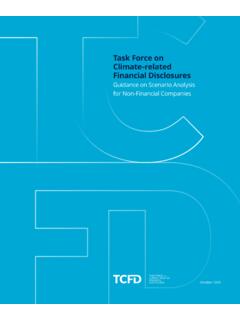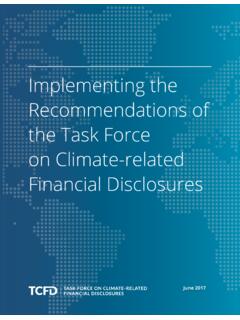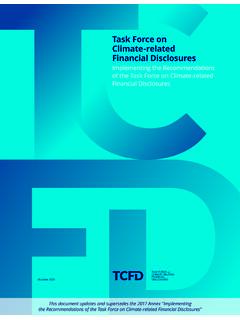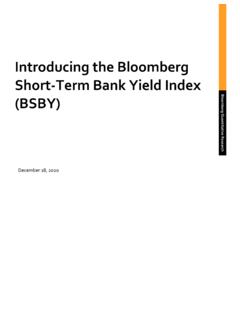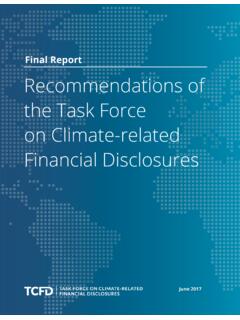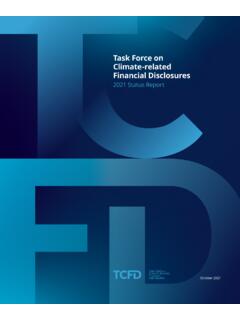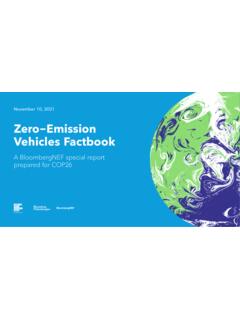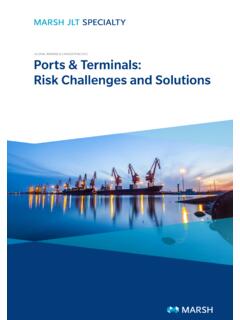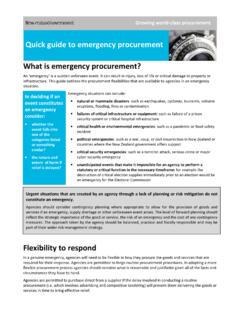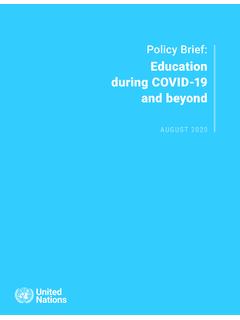Transcription of Overview - assets.bbhub.io
1 March 2021 Task Force on Climate-related Financial Disclosures OverviewB1 The Need for Climate-Related Financial Disclosure 2 Potential Financial Implications of Climate Change 4 The Task Force on Climate-related Financial Disclosures 6 Demand for Climate-Related Financial Disclosure 10 Climate-Related Risks and Opportunities 12 The TCFD Recommendations 14 TCFD Recommended Disclosures 16 Guidance on Implementing the TCFD Recommendations 20 Sector-Specific Supplemental Guidance 22 Summary of 2020 Guidance and Other Work 24 Implementing the TCFD Recommendations 26 Benefits of Implementation 28 Select Resources on the TCFD Recommendations 30 TCFD Supporters 32 Overview of the TCFD 2020 Status Report 34 Examples of Momentum for the TCFD 36 Contents23 The Need for Climate-Related Financial DisclosureThe Need for Climate-Related Financial Disclosure1 Source: Munich Re, The natural disasters of 2018 in figures, 8 Jan 2019, and Hurricanes cause record losses in 2017 The year in figures, 4 Jan 2018.
2 Corporate-news/media-information/2020 Source: The Economist Intelligence Unit, The Cost of Inaction: Recognising the Value at Risk from Climate Change, catastrophe losses intensified by climate change (2017-2019)1$640bup to $43tValue at risk as a result of climate change to manageable assets by 21002 Mark Carney, UN Special Envoy on Climate Action and Finance and Michael R. Bloomberg, TCFD Chair Now is the time to ensure that every financial decision takes climate change into account. Mark Carney, UN Special Envoy on Climate Action and Finance, Governor of the Bank of England, December 2019 The large-scale and complex nature of climate change makes it uniquely challenging, especially in the context of economic decision making.
3 Further, many companies have incorrectly viewed the implications of climate change to be relevant only in the long term and, therefore, not necessarily relevant to decisions made today. Those views, however, are changing as more information becomes available on the potential widespread financial impacts of climate December 2019, Bank of England Governor Mark Carney noted that changes in climate policies, new technologies and growing physical risks will prompt reassessments of the values of virtually every financial asset. Companies and providers of capital, therefore, should consider their longer-term strategies and most efficient allocation of capital in light of these changes.
4 Organizations that invest in activities that may not be viable in the longer term will likely be less resilient to the transition to a lower-carbon economy and their investors will likely experience lower returns. Compounding the effect on longer-term returns is the risk that present valuations do not adequately factor in climate-related risks because of insufficient information. Investors, lenders, and insurance underwriters need adequate information on how companies are preparing for a lower-carbon economy. More effective, clear, and consistent climate-related disclosure is needed from companies around the Financial Implications of Climate ChangePotential Financial Implications of Climate ChangeRise in Natural Catastrophes and Chronic Environmental Shifts Macroeconomic shocks or financial losses caused by storms, droughts, wildfires, and other extreme events, or by changing weather patterns over time Unanticipated financial losses resulting from climate change ( , the effect of rising sea level on credit secured by coastal real estate)
5 Could impact the global financial systemTransition to a Low-Carbon Economy Risks associated with an abrupt adjustment to a low-carbon economy, such as rapid losses in the value of assets due to changing policy or consumer preferences Climate-related financial risks could affect the economy through elevated credit spreads, greater precautionary saving, and rapid pricing readjustments Climate-related risks are a source of financial risk and it therefore falls squarely within the mandates of central banks and supervisors to ensure the financial system is resilient to these risks. Network for Greening the Financial System, First Comprehensive Report, April 2019 Climate Change is a Financial Risk Climate-related risk is non-diversifiable and will have a financial impact on many companies:CAPITAL AND FINANCINGASSETS AND LIABILITIESEXPENDITURESREVENUES67G20 Finance Ministers and Central Bank Governors asked the Financial Stability Board (FSB) to review how the financial sector can take account of climate-related FSB established the Task Force on Climate-related Financial Disclosures (TCFD) to develop recommendations for more effective climate-related disclosures that.
6 Could promote more informed investment, credit, and insurance underwriting decisions in turn, would enable stake-holders to understand better the concentrations of carbon-related assets in the financial sector and the financial system s exposures to climate-related risks. The Task Force on Climate-related Financial DisclosuresThe Task Force on Climate-related Financial DisclosuresChapter name589 Industry Led and Geographically Diverse Task ForceThe Task Force on Climate-related Financial Disclosures1786 Experts from the Financial SectorExperts from Non-Financial SectorsOther Experts The Task Force s 31 international members, led by Michael Bloomberg, include providers of capital, insurers, large non-financial companies, accounting and consulting firms, and credit rating for climate-related disclosure has increased significantly since the release of the TCFD recommendations in 2017.
7 Many private sector financial institutions, investors, and others continue to make progress on incorporating climate-related disclosure into their financial decision-making. For example, over 500 investors with more than $47 trillion in assets under management committed to engagewith the world s largest corporate greenhouse gas emitters to strengthen their climate-related disclosures by implementing the TCFD recommendations as part of Climate Ac tion 100+.Demand for climate-related disclosure from investors and others is critically important. In particular, large asset owners and asset managers sit at the top of the investment chain and, therefore, have an important role to play in influencing the organizations in which they invest to provide better climate-related financial for Climate-Related Financial DisclosureDemand for Climate-Related Financial Disclosure It is necessary for all parties in our investment chain, from portfolio companies to asset managers, to support TCFD so that asset owners like us can properly access our portfolio.
8 I am convinced that TCFD will continue to evolve as a major framework for such disclosure and strongly recommend all corporates to join. Hiro Mizuno, Former Executive Managing Director and CIO Japan Government Pension and Investment Fund, February 2020In addition, public sector leaders have also noted the importance of transparency on climate-related issues within financial markets. Climate-related risk is increasingly the subject of new reporting requirements, such as the European Non-financial Reporting Directive 2014/95/EU, stress testing, and regulatory guidance based on the TCFD recommendations. A number of national governments and public sector organizations formally support the TCFD.
9 The NGFS emphasises the importance of a robust and internationally consistent climate and environmental disclosure framework. NGFS members collectively pledge their support for the recommendations of the Task Force on Climate-related Financial Disclosures (TCFD). The NGFS encourages all companies issuing public debt or equity as well as financial sector institutions to disclose in line with the TCFD recommendations. Network for Greening the Financial System First Comprehensive Report, April 2019 Climate-Related Risks and OpportunitiesClimate-Related Risks and OpportunitiesThe Task Force identified several categories of climate-related risks and opportunities.
10 These include potential financial impact to assist investors, and companies consider longer-term strategies and most efficient allocation of capital in light of the potential economic impacts of climate TransitionPolicy and Legal Carbon pricing and reporting obligations Mandates on and regulation of existing products and services Exposure to litigationTechnology Substitution of existing products and services with lower emissions options Unsuccessful investment in new technologiesMarket Changing customer behavior Uncertainty in market signals Increase cost of raw materialsReputation Shift in consumer preferences Increased stakeholder concern/negative feedback
